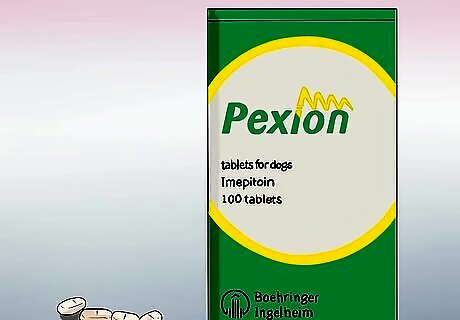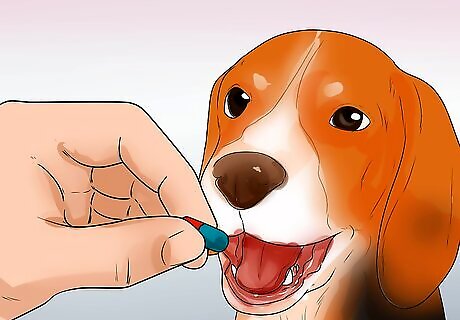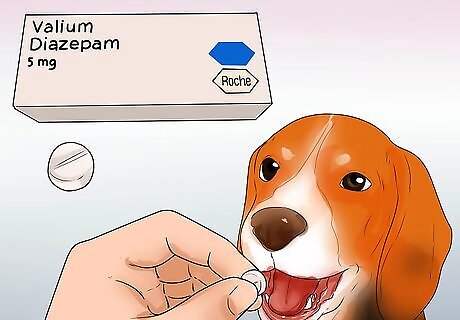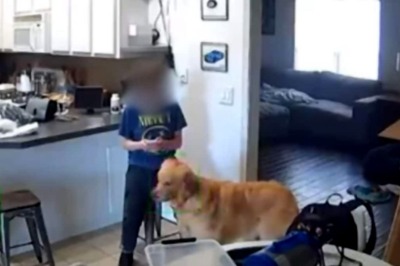
views
X
Research source
Epilepsy is often misunderstood, as not all dogs that have seizures have epilepsy, but all dogs with epilepsy have seizures. The diagnosis of epilepsy is applied to dogs that have seizures where no underlying cause can be found. This means to reach a diagnosis of epilepsy the dog must have had blood tests to rule out organ disease and infection, and an MRI scan to eliminate a brain tumor or inflammation.[2]
X
Research source
Because its such a serious condition, it's important to be able to spot the signs of the condition in order to get it treated.
Getting Veterinary Treatment

Take your dog to the vet. Your vet will do some testing to rule out other possible causes for the seizures. If no cause for the beagle's seizures is identifiable, the dog is assumed to have epilepsy. The veterinarian may want to test for poisoning, liver disease, diabetes, kidney disease, and anemia, among other health issues. At this point, treatment depends on the use of anticonvulsant drugs to suppress abnormal electrical activity in the brain, rather than treating the underlying cause.

Discuss whether treatment with an anticonvulsant is necessary. Anticonvulsant drugs do have side effects, so whether to treat a beagle for epilepsy or not depends on weighing up a number of factors. As a general rule of thumb, those dogs that need treatment are those who have severe, prolonged seizures (lasting more than 5 minutes each), frequent seizures, or clusters of seizures. There is no set rule as to what "frequent" seizures are, and this is usually assessed on an individual basis against how severe the fit is and if the dog has clusters (groups of seizures on the same day). One seizure a month is usually the threshold at which therapy is started.

Choose an anticonvulsant. There are different anticonvulsants that are available. Different anticonvulsant drugs work in different ways, and around 25-33% of epileptic dogs require more than one medication in order to satisfactorily control their symptoms. Two drugs are currently licensed for use in dogs for the treatment of epilepsy and these are Epiphen (phenobarbitone) and Pexion (Imepitoin). Pexion: This is a relatively new drug that builds up to therapeutic levels in the bloodstream much faster than Epiphen. The dog is started at an initial dose of 10mg/ kg, which is given as a tablet by mouth every 12 hours. The drug is more effective given on an empty stomach, and dosing should be kept as close to every 12 hours as possible. Pexion reaches a steady therapeutic level within 7 days, which is considerably faster than for alternative drugs. Pexion should not be given to beagles with serious liver or kidney disease. Epiphen: Epiphen has been available for much longer than Pexion and is more commonly used. However, it takes at least two weeks to climb to therapeutic levels in the blood, so decisions about dose adjustments should not be made during that time. Epiphen is strongly associated with ravenous appetite, increased thirst, and poor coordination on the back legs, and is not a drug that suits all dogs. High doses cause more severe side effects, so rather than increase the dose to high levels, introducing a second anticonvulsant may be the better option.
Caring For an Epileptic Beagle at Home

Give treatment regularly. Once started on anticonvulsants, it is essential that the medication is given regularly and not stopped suddenly. To do so risks the patient having more severe seizures in the future. Drugs such as Epiphen have a short acting effect and if the next dose of drug is late, the dip in blood levels can be sufficient to induce a seizure in some patients. Never adjust the dose of an anticonvulsant medication without first speaking to your vet.

Prepare to help your dog with the side effects of anticonvulsants. Anticonvulsant drugs have side effects, such as sedation, hunger, or thirst, which can seriously interfere with the dog's quality of life. The dose of drug that would completely prevent seizures might well make the dog so sleepy and poorly coordinated that it can't take part in normal family life. The drugs can also cause liver damage. The aim of treatment is therefore a compromise between reducing the frequency of the seizures by at least half, while maintaining the dog's good quality life.

Give your dog medication to minimize additional seizures. Dogs that are not started on anticonvulsants because their seizures are infrequent (less frequent than once a month) or mild, may be supplied with a diazepam rectal suppository. This is given to the dog immediately after a seizure, as the diazepam is absorbed through the rectal mucosa to enter the bloodstream where it dampens down electrical activity in the brain and makes another seizure in the next few hours less likely. This is helpful because in some dogs, one seizure follows on the coattails of another, in what are called seizure clusters. Giving diazepam can decrease the likelihood of this happening.

Document your dog's seizures. You should maintain a log of seizures so you can really understand how often and how severe they are. You should also take video of seizures, if you can. This will be good information to share with a vet. The log should include the date, the time, and the length of the seizures.

Make the environment safe for your dog. When a dog has seizures it's important to remove dangerous objects from the area, so that it does not get injured. If you can, move furniture that has sharp edges and hard objects away from a seizing dog. If you have a dog with a history of seizures, it may be a good idea to take items that it could hurt itself on out of the areas is spends its time in. For example, if your dog's bed is next to a sharply-edged table, you should move either the bed or table.
Identifying Epilepsy

Be on the look out for seizures. Beagles that have epilepsy will have seizures. During the seizure itself, the dog loses consciousness, and often lies on its side and paddles uncontrollably with the legs. The dog's jaw may also be clenched. The owner should take care not to be bitten, as the dog won't be able to release their bite. Many dogs also lose control of their bladder and bowels during a fit. Most seizures last for just a couple of minutes.

Look for secondary behavioral symptoms. Dogs about to have seizures often have a phase of strange behavior preceding the seizure. This strange behavior may include restlessness, being unsettled, and being clingy. Your dog may also come to you seeking reassurance.

Keep an eye on breeds that are more likely to have epilepsy. Some dog breeds have an inherited component to their epilepsy and acquire genes from their parents that makes seizures more likely. The beagle is one of these breeds. Along with beagles, Cocker spaniels, Dachshunds, German shepherds, Irish setters, Labrador retrievers, golden retrievers, poodles and keeshonds have high rates of epilepsy.



















Comments
0 comment